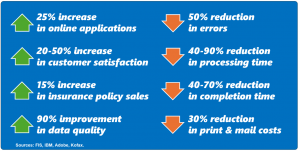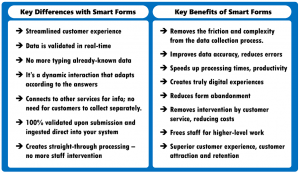Published on the 06/06/2024 | Written by

And what’s the next gen in data collection?…
Static webforms and PDF fillable forms are on their way out, and smart forms are taking over. But many businesses still haven’t got the memo. It’s about as smart as sticking with dumbphones because ‘that’s the way we’ve always done things around here’.
“Too many people are still not in-the-know about smart forms.”
Let’s take a look at what’s going on, why, and the next generation in data collection.
The Old World
When I was a little kid, I thought it must be terribly tough being a grown up. I would see my dad hunched over the kitchen table, all red-faced and crotchety, shuffling papers and huffing.
There were three things he hated most: Paying bills, tax time and filling out forms.
Things are much easier now 50 years later with streamlined bill payment and tax management, but somehow forms are still basically the same as they were back then!
Admittedly, PDF fillable forms and webforms offer some improvement with a more digital interaction, but they are still basically the same thing, just digital. Not particularly smart.
I don’t get as frustrated with forms as my dad, but it does feel ridiculous repeatedly filling out the same information already known to the business, such as my address details. Could they not be more ‘grown up’ as a business and provide a more mature experience?
Static webforms and PDF forms provide poor customer experiences that lead to form abandonment. Customers are often required to self-navigate choose-your-own-adventure forms. And with the likelihood of forms being completed incorrectly, they trigger customer service follow-ups about 50-70 percent of the time.
The New World
Smart forms arose from reimagining the data collection process.
What if you could make the process much easier and more natural, like a human conversation or interview?
What if you could create a dynamic journey that adapts according to existing information and answers provided?
What if you could connect to other services (like MyGov, Medicare, VicRoads, ID services, etc) to collect or verify data, so the customer doesn’t need to?
What if the data collection process were as smooth and simple for the customer as technologically possible?
Unsurprisingly, it turns out to yield far superior results.
Here are the results from case studies with Westpac, ANZ Bank, ATO, Telstra, Sydney Water, Lloyds Banking, ADF, NAB, Suncorp, and Origin Energy, among others, when they switched from PDF to smart forms:

Despite such clear and unambiguous outcomes, about 50 percent of financial businesses are still hanging their hats on PDF forms. Too many people are still not in-the-know about smart forms, even though they first emerged 20 years ago. But once you cross over, there is no looking back. It’s a new life with a new level of power and possibility at your fingertips.
Key Differences, Benefits, and Use Cases
You can capture the key differentiators and benefits in this snapshot overview:

When considering where and when to use this kind of technology, the key target areas for improvement in any business are downloadable forms that need to be printed and signed, PDF fillable forms, static (non-dynamic) webforms and mission-critical business processes, anything ripe for automation and straight-through processing (such as onboarding, servicing, renewals).
But why should you be talking to me first, rather than any other smart forms provider?
I’m glad you asked.
We have the next-gen market disruptor in smart forms technology. It is a leap ahead of all other solutions with unique, patented capabilities.
Among our key main differentiators are:
- Patented NanoSites technology which completely reimagines digital data collection. For example your people can create forms on-the-fly and send them to customers via SMS or email with QR codes prepopulated with data so the customer only needs to click one button to close or accept that call to action. It’s PCI compliant as well.
- Low code, no code and can be deployed in hours/days.
- The technology is built on an IDE. You can flexibly build apps with it, tailored to suit.
- Elegant drag-and-drop workflow and journey builder for easier development so users are more productive.
- As much or as little as you need. It can extend and enhance existing investments or completely retire significant amounts of digital debt
- Complex technological hurdles resolved – uniquely achieved by our team for this solution
- Great feedback. Described as “exceeded our initial expectations”, “presents significant potential,” “offers widespread benefits,” and “could prove extremely valuable” by a Business Analyst we recently showed it to.
It’s only a matter of time before everyone has seen the light and only laggards are left to play catchup. It’s like when my dad was so resistant to switching his dumbphone for a smartphone. It took ages getting him to budge. But now he’s on it, he’s delighted! When you move to smart forms, you will be too.
There’s plenty of money left on the table for savvy businesses to pick up and stay at the forefront, reaping the benefits.
 Russ Townsend is Senior Solutions Executive, A/NZ, for Cincom Systems, helping A/NZ organisations with high volume customer communications needs to improve their communication performance.
Russ Townsend is Senior Solutions Executive, A/NZ, for Cincom Systems, helping A/NZ organisations with high volume customer communications needs to improve their communication performance.
If you would like to contact Russ, please get in touch here.
rtownsend@cincom.com or https://www.linkedin.com/in/russtownsend/.



























